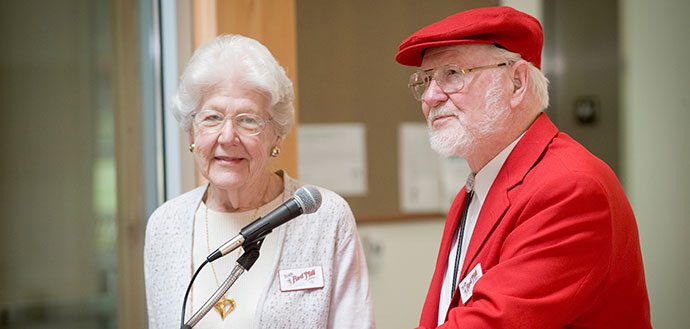
Great partnerships are “like a marriage,” says Charlee Moore. “You just hang in there and do the best you can.”
Good advice from Bob Moore’s soft-spoken partner – and inspiration for Bob’s Red Mill – on the partnership between the CPHHS and the business she and Bob founded 40 years ago.
The Moores were in town being fêted by the college for their $5 million gift funding the new Moore Family Center for Whole Grain Foods, Nutrition and Preventive Health, which provides for an endowed director, additional professor, the renovation of food labs in Milam Hall, and two programmatic funds to support the center’s research and outreach, including a fund focused on childhood obesity. It is the second largest gift in the college’s history, second only to the $8 million commitment from Hallie E. Ford, which created the Hallie E. Ford Center for Healthy Children and Families in 2007.
“Just look where it’s gone,” Bob said of Charlee’s vision and determination for feeding her family nutritious meals using whole grains.
Outspoken and passionate about healthy eating and fighting the obesity epidemic, Bob attributes the latter to a love of money, particularly the “people who make money off food that makes us fat and sick.”
For Bob, fighting the epidemic is just that – a fight. “Expect resistance,” he said. “Fight. Stand up and make this a healthier country and world. Be strong in your convictions and for whole grain foods and foods that make strong bodies.”
He just may be on to something. Eighty-three-year-old Bob Moore is active in his business and philanthropic affairs and kept pace on what was a busy day of celebration, first enjoying lunch with OSU President Ed Ray, CPHHS Dean Tammy Bray, Moore Family Center Director Emily Ho and OSU Foundation staff before touring the renovated food labs in Milam Hall and tasting recipes* created by CPHHS nutrition students.
The Moore Family Food Labs in Milam underwent a complete transformation prior to the Moore’s visit, including state-of-the-art equipment and dietary assessment labs. In some cases, equipment from the ’50s was swapped out for the latest models.
At a public reception at the Hallie E. Ford Center, President Ray made a point to emphasize how the Moore’s inspiration and generosity are enabling OSU to address issues critical to Oregon and our nation.
“These issues are not a secret to anyone here,” he said. “They are the quality of our nutrition; the impact of what we eat on our health and longevity; and the terrifying present and future impact of the epidemic of obesity underway in our country.”
“The Moores are pivotal in building and extending OSU’s capacity in nutrition and health,” he said, before addressing students in attendance. Follow Bob and Charlee’s lead, he told them, especially “their openness to new ideas and discoveries, their commitment to a nutritional philosophy, and most of all their passion for helping people live better and enjoy life more fully.”
By doing so, he said, “I think you will find a very sound model for how to pursue your dreams and be open to the unexpected opportunities life presents.”
Dean Tammy Bray took the opportunity to recognize the seeds for good health that the Moores have planted with this gift, to introduce Ho and to literally and figuratively give her the key to this new center, as she did with Hallie E. Ford Center Endowed Director Rick Settersten.
Ho, an associate professor of nutrition and a successful researcher whose work has increased our understanding of how food can improve our health and well-being and prevent disease, praised the Moore’s vision before sharing her own.
“The mission of the center has been inspired by the Moore’s philosophy that we need to help people eat healthier foods, such as whole grains,” she said. “I see this center as a catalyst, the epicenter for food and nutrition, to get us all working together, including Extension, which provides a great model of identifying community needs and looking for collective solutions locally.”
People are hungry for information not only on what makes a certain food or diet nutritious, healthy and delicious, but also how to make that applicable in their own ways and circumstances, she said.
“Consider this: even though most people claim to know that whole grains are good for you, 40 percent are not eating any whole grains, and less than 10 percent are eating the recommended allowance. It is clear there is a huge gap between science and application. We need to make concerted efforts together using multidisciplinary approaches to move those numbers for healthy eating in a positive direction, and this center will be a conduit for producing evidence-based knowledge and practice and getting great science to the community.”
*Some of these recipes were submitted as part of Let’s Move! In association with the U.S. Department of Agriculture (USDA), Let’s Move! is challenging school nutrition professionals, chefs, students, parents and interested community members to create tasty, healthy, exciting new recipes for inclusion on school lunch menus across the country.









